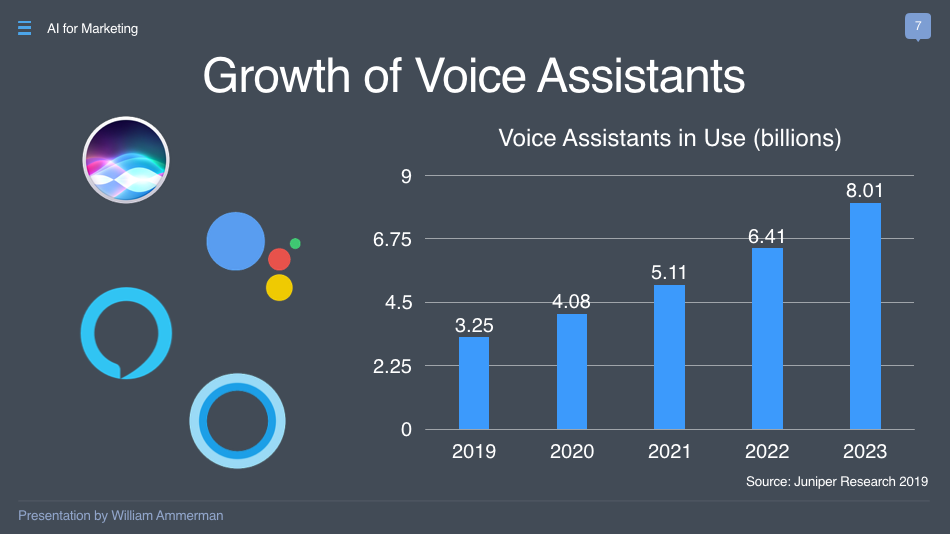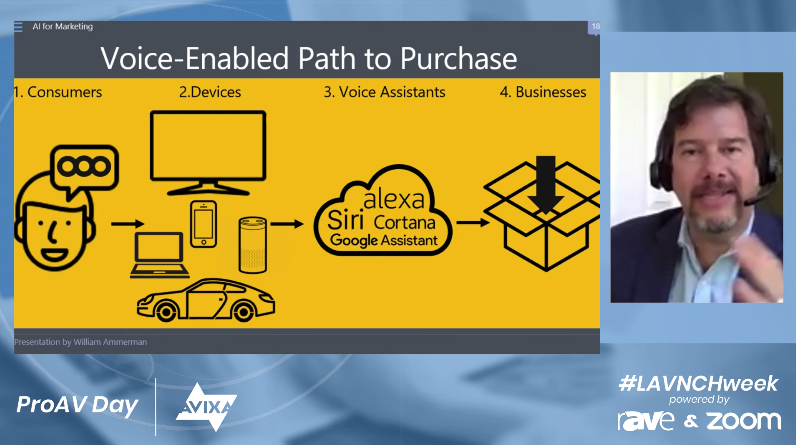LAVNCH WEEK ProAV Keynote: AI and Voice Are the Future, with William Ammerman — The Blog Version

“Artificial intelligence is already at work changing you”: a provoking idea, direct from our second LAVNCH WEEK ProAV Day keynote presenter, William Ammerman — author of McGraw-Hill’s “The Invisible Brand: Marketing in the Age of Automation, Big Data, and Machine Learning.”
Ammerman’s keynote today for ProAV Day of LAVNCH WEEK, “AI and the Voice User Interface,” was structured around a hot topic in our industry right now — artificial intelligence and voice control. The thought, backed by a whole lot of colorful points and even more colorful data, is that artificial intelligence and voice control are the future, especially in the context of AV.
We have to agree. If you’re an integrator in the commercial AV industry and you’re NOT thinking about AI and voice in your installations, you’re behind. For the next 30 minutes of his keynote, Ammerman attempts to convince us on the importance of voice and AI and why we should embrace it.
We think he succeeded. Here’s the summary of William Ammerman’s keynote from ProAV Day today, in case you missed it live.
The Four Marketing Trends Powered by Voice/AI
This technology is tapping into something deeper in our brains. On voice technology and the psychology behind it, Ammerman shared, “This technology hacks our empathy and operates on us psychologically.”
Ammerman continued by taking us through the four marketing trends powered by artificial intelligence. Those include:
- “Personalization of information.” We have moved into an age where information can be delivered to you — just to you — through “mass customization.” Brands can now personalize their messaging to individuals based on all the data they’ve collected about us, whether you like it or not.
- “Persuasion as a science.” Media algorithms reward us by “telling us what we want to hear.” Those algorithms are now very good at figuring out what keeps you coming back.
- “Machine learning.” There’s prediction, then there’s machine learning (which helps us prescriptively change our marketing behaviors). Ammerman, adds, algorithms don’t just predict anymore — they actually learn from their past data.
- “Natural language processing.” We are willingly talking to our machines and devices, like Alexa, giving them more information willingly. This opens us up to a level of persuasion unlike anything we’ve seen before.
None of this should come across as “a bad thing,” but it does take a true understanding of voice/AI data to do this securely and correctly in the AV industry; AV solutions like NEC’s Analytics Learning Platform (ALP), an anonymous analytics platform, frame it well: “Our seamless process allows retailers to better understand who their customer is, what they’re buying and why they’re buying it. The insights from this information allow the team to increase future engagements, enhance the overall guest experience — and drive purchase.”
Voice Assistants are Growing (Here’s Hard Proof)
Ammerman’s breakdown on the four marketing trends powered by AI reveal that, without a doubt, voice assistants are growing and should be a top consideration in your AV installs. Take a look at some of the data provided on their growth (numbers provided are in billions).

Of these, the most popular voice assistants are Siri (by apple), the Google Assistant (by Google), Alexa (by Amazon) and Cortana (by Microsoft).
Mid-presentation, we get Ammerman’s key predictions and takeaways (if you don’t read anything else in this recap, read point #1), related to the growth of voice:
- “The Voice User Interface (VUI) is the consumer-facing edge of artificial intelligence at the world’s most valuable brands.” In other words, voice ecosystems are a permanent part of the marketing ecosystem and people’s lives now; businesses will either have to build their own voice ecosystems or play in the “sandbox” of those that are already doing it.
- “Voice Commerce will reach $80 billion worldwide by 2023.” Furthermore, Ammerman shares, a prediction by Garter states that, by 2021, early adopter brands that redesign their digital presence to support voice will increase digital commerce revenue by 30% (compared to if they hadn’t made that investment).
Four Steps Forward Related to Voice/AI
You have to be an early adopter in this technology. With $80 billion on the line, here’s what you need to do now to ensure a clear path to purchase via voice, according to Ammerman.

- Step 1: Understand your customer’s use of voice. What’s their gender identity and age demographic? Are they using voice mostly while driving (a top use case for voice) or at home? What are they using it for?
- Step 2: Understand the devices they use. Are they using their smartphones with voice? Connecting their phones via Bluetooth in their cars? What about smart speakers (Amazon Echos, a Google Home) in the home? Ammerman also shared that your next smart speaker will be your TV, with Samsung and other major manufacturers announcing that new models of smart TVs will be equipped with voice recognition.
- Step 3: Learn the differences between voice assistants. Learn the nuances between voice assistants and how they’re used on phone versus desktop versus smart speaker. Know that voice “flattens” search, often pulling from Google’s featured snippet or from the “knowledge graph” to the right of Google results.
- Step 4: Ask, “Are your products ready for voice?” Do a test run for your own product/brand related to voice search — try searching for your product/company information via voice. How did that go?
Whether you’re only getting started with voice and AI in your integrations, or you’re already heavily invested in these technologies, we hope Ammerman’s talk gave you a bit of a kick to get you moving on them.
If you need a bit of inspiration, look to brands like Domino’s — which allows ordering through Alexa, Google, Home and even Samsung smart TVs); the pizza joint has had major success with voice control to date.
So, like Ammerman asks, does your brand talk?
Join us for LAVNCH 2.0!
If you’ve enjoyed LAVNCH WEEK so far and are interested in attending LAVNCH 2.0 the week of June 22 (it’s free for attendees!), go ahead and join the list here; spots will fill up fast. Also, you can check out our LAVNCH WEEK microsite here to see all the articles (like this one) and public videos from the week and more.





